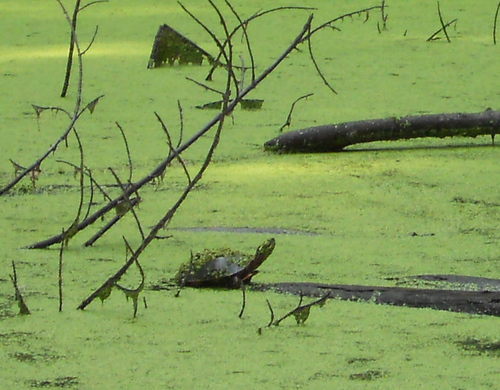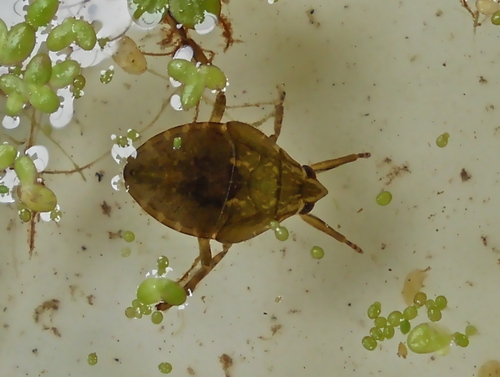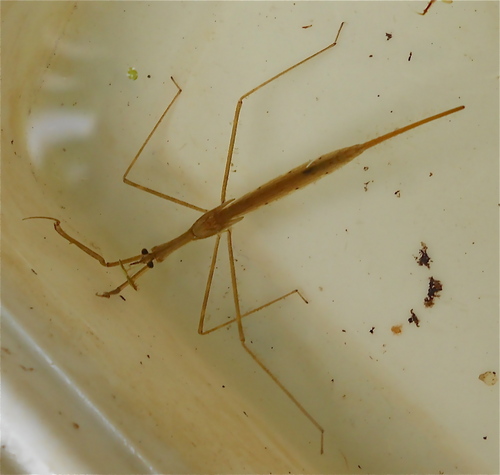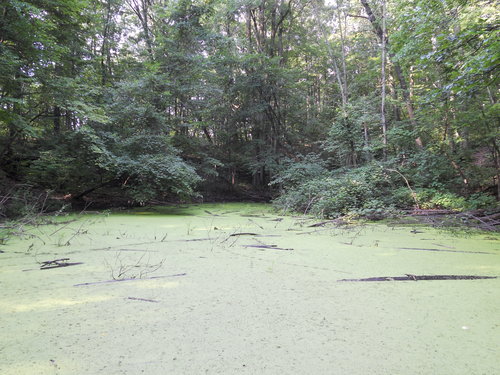Pondcast 30: Getting buggy at Black Pond

Painted turtle at Black Pond.
In the midst of a jam-packed summer schedule, Jameson, Alex, and I headed to Black Pond on July 28. Male cicadas were heard vociferously calling from the treetops. Green frogs were still actively seeking mates. The pond level was noticeably lower, but covered with duckweed.
Unusual, however, was the occasional bubble in random locations across the pond breaking the water’s surface. What was the cause of this activity? Gas from decomposing matter? Tadpoles? Bugs? Aliens?
Aliens were immediately ruled out, both boys groaning at their father’s inane sense of humor. The bubbles were too big to be gas since duckweed was also pushed up. Plus no residual bubbles remained. So it had to be an animal.
Lying on my belly at the edge of the floating boardwalk, I waited patiently for several minutes for one of the bubbles to pop up within reach of my net. Rewarded I was with a brown, hard-backed, oval-shaped insect, about the size of a quarter.

Giant Water Bug Nymph
This insect turns out to be a nymph of the giant water bug. GWBs are in the insect order, Hemiptera, the “true bugs” in the suborder, Heteroptera, the “true water bugs” which include water scorpions (discussed below) and backswimmers. GWBs belong to the family, Belostomidae. GWBs can grow to be two to three inches long; some Asian species can be an inch or two longer and are eaten by humans!
Like other “true water bugs,” GWBs use their piercing/sucking mouthpart to inject digestive fluids into their prey, so their bite is quite painful -- hence the reason GWBs are colloquially known as “toe-biters.”
GWBs chow down on fish, aquatic crustaceans and amphibians. With the loss of water due to evaporation and the large numbers of green frog tadpoles, GWBs dine well in Black Pond. But these creatures are difficult to catch.
As adults, GWBs are capable of flight, but do so at night and are attracted to artificial lights. So once the pond dries out in fall, these critters will likely move on to new habitats.

Water Scorpion - Genus Ranatra
Another “true water bug” collected in Week 30 was a water scorpion in the family Nepidae. There are two forms of this insect. One of which looks similar to the giant water bug. The other form looks similar to the insect known as a walking stick. We found the stick variety this week, of the genus Ranatra.
Water scorpions feed primarily on aquatic invertebrates, but will dine on amphibians. These insects get their name because someone thought that their front legs look like the pedipalps (clawed legs) of a true scorpion. I suppose that the similarity would be if the water scorpion’s front legs were analogous to Popeye’s forearms before eating spinach and the scorpions pedipalps would be Popeye’s arms after eating spinach.
Observed also in Black Pond during our Week 30 visit were a painted turtle, a damselfly nymph, phantom midge larvae, flatworms (or planarians), and what appeared to be mosquito larvae.

Black Pond on 28 July 2010
You can see all the Pondcast videos by visiting the YouTube channel of Stefan Szumko, AKA slugwhisperer at http://www.youtube.com/user/slugwhisperer.
Stefan Szumko is a middle school science teacher by trade, an outdoor environmental educator by calling and a homedaddy by choice. He can be reached at slugwhisperer@gmail.com.

